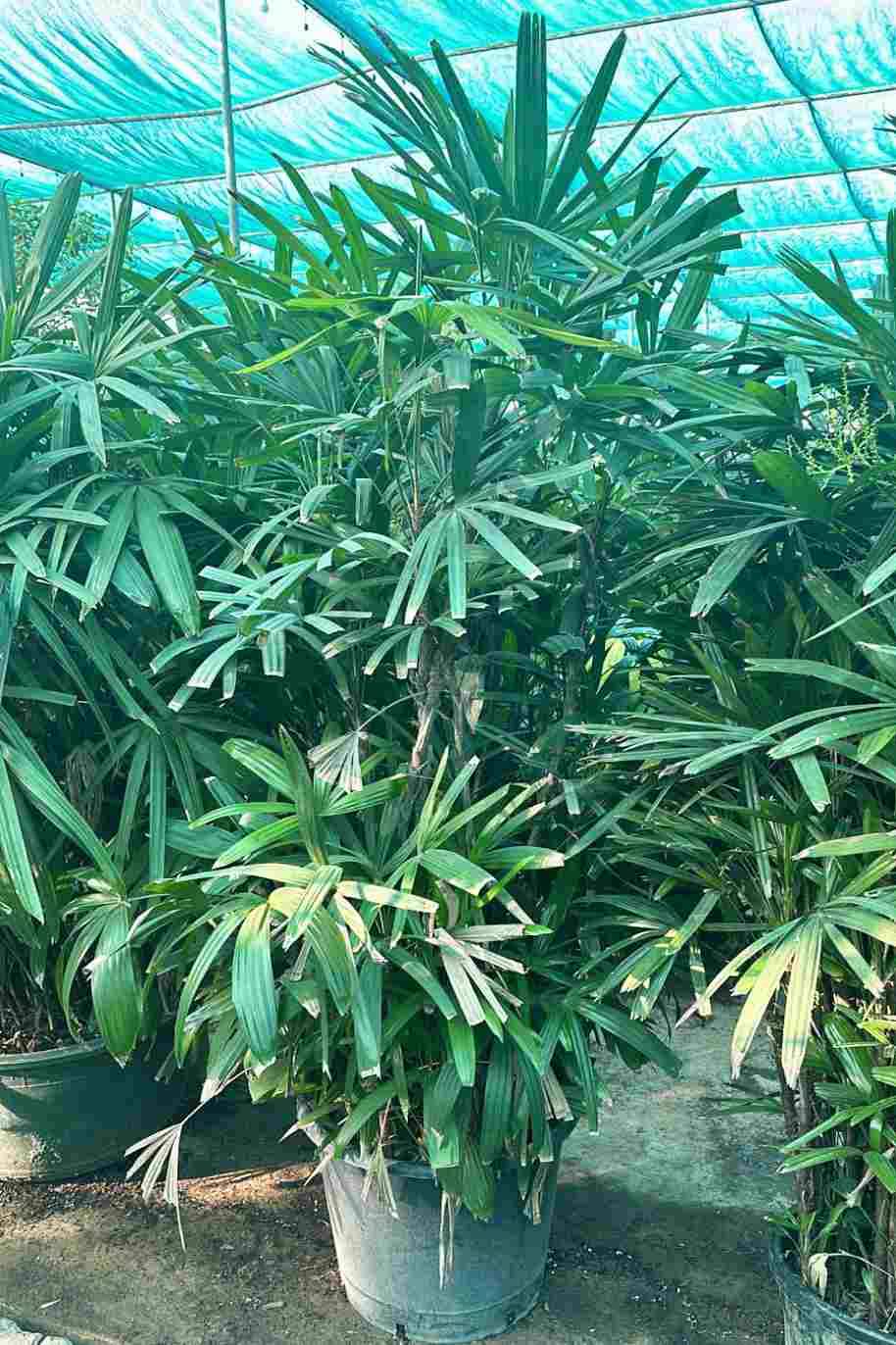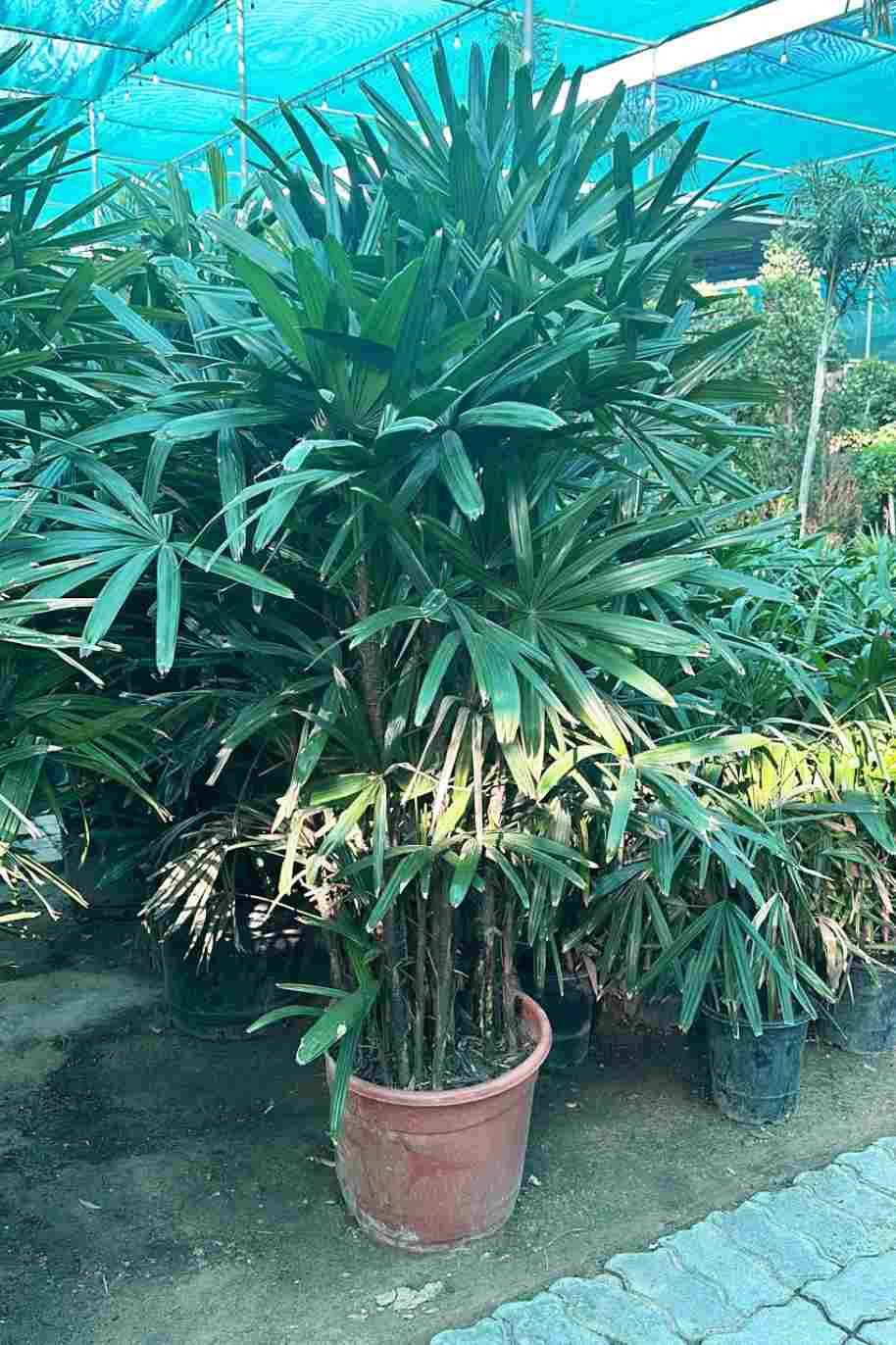Rhapis Excelsa Bushy Tall for Sale Online | Quick Delivery in the UAE | Plantshop.me
Dismiss



Rhapis Excelsa Bushy Tall
Rhapis Excelsa
SKU 6076
AED 945
Qty
Choose your delivery location
Plant Bio
Rhapis excelsa, commonly known as Lady Palm, is a versatile and attractive palm species prized for its elegant appearance and resilience. It is native to Southeast Asia, particularly China and Japan, where it grows in shaded understory environments. Lady Palm is characterized by its dense clusters of fan-shaped leaves and slender, bamboo-like stems. Here's a general description:
Foliage: Rhapis excelsa features deeply divided, fan-shaped leaves that grow in dense clusters at the tips of multiple stems. The leaves are glossy and dark green in color, with segments that radiate outward from a central point, giving them a distinctly elegant appearance. The foliage remains attractive throughout the year and provides a lush, tropical ambiance to outdoor landscapes.
Stems: The stems of Rhapis excelsa are slender, bamboo-like, and covered with persistent leaf sheaths that add to the plant's ornamental appeal. The stems grow in dense clumps, forming a bushy, multi-stemmed growth habit that adds volume and texture to outdoor plantings.
Size: Lady Palm typically reaches heights of 6 to 12 feet (1.8 to 3.6 meters) in outdoor landscapes, with a spread of 3 to 6 feet (0.9 to 1.8 meters). It grows at a slow to moderate pace, making it suitable for various outdoor settings, including garden beds, borders, and container plantings.
Flowers and Fruits: While Rhapis excelsa may produce small, inconspicuous flowers and fruits under ideal growing conditions, it is primarily grown for its attractive foliage rather than its blooms or fruiting. The flowers are often hidden within the leaf clusters and are not a significant ornamental feature of the plant.
Care Guide for Rhapis Excelsa (Lady Palm) - Outdoor:
Light: Plant Lady Palm in partial shade to full shade outdoors, where it receives filtered sunlight or dappled shade throughout the day. Avoid placing the plant in direct sunlight, especially during the hottest part of the day, as it can lead to leaf scorching and discoloration. Ideal locations include shaded garden beds, under tall trees, or on the north or east side of buildings.
Temperature: Lady Palm thrives in warm, subtropical to tropical climates and is well-suited to USDA hardiness zones 9b to 11. It prefers temperatures between 65°F to 85°F (18°C to 29°C) during the day and above 50°F (10°C) at night. Protect the plant from cold drafts, frost, and freezing temperatures, as prolonged exposure can damage the foliage and stems.
Soil: Plant Lady Palm in well-draining, fertile soil with a slightly acidic to neutral pH (around 6.0 to 7.0). A loamy or sandy soil enriched with organic matter such as compost or aged manure works well. Ensure that the soil retains moisture while allowing excess water to drain away to prevent waterlogging, which can lead to root rot.
Watering: Keep the soil consistently moist but not waterlogged, especially during the growing season (spring through fall). Water Lady Palm regularly, ensuring that the top few inches of soil remain evenly moist. Reduce watering frequency during the winter months when growth slows down. Use a watering schedule based on local weather conditions, soil moisture levels, and the plant's water needs.
Mulching: Apply a 2 to 3-inch (5 to 7.5-centimeter) layer of organic mulch, such as shredded bark or compost, around the base of Lady Palm to conserve soil moisture, suppress weed growth, and regulate soil temperature. Keep the mulch several inches away from the stems to prevent moisture-related issues and stem rot.
Fertilization: Feed Lady Palm with a balanced, slow-release fertilizer formulated for palm trees or tropical plants in spring and summer. Follow the manufacturer's instructions for application rates and frequency. Avoid overfertilizing, as it can lead to excessive foliage growth at the expense of overall plant health.
Pruning: Prune Lady Palm as needed to remove any yellowing, damaged, or dead leaves and maintain a neat and tidy appearance. Use sharp, sterilized pruning tools to make clean cuts and minimize the risk of disease transmission. Regular pruning also helps stimulate new growth and rejuvenate the plant over time.
Pest and Disease Control: Monitor Lady Palm regularly for signs of common pests such as spider mites, aphids, scale insects, and mealybugs. Treat infestations promptly with insecticidal soap, neem oil, or horticultural oil. Ensure good air circulation around the plant and avoid overcrowding to minimize the risk of fungal diseases such as leaf spot or root rot.
Container Growing: Lady Palm can be grown in containers or large pots filled with well-draining potting mix. Choose a container with drainage holes and water the plant regularly to keep the soil evenly moist. Repot the plant into a slightly larger container every 2 to 3 years to provide room for root growth and refresh the potting mix.
Propagation: Lady Palm can be propagated from division or offsets produced by mature plants. Carefully separate the offsets from the parent plant and plant them in individual pots filled with moist potting mix. Keep the newly planted offsets in a warm, humid environment with filtered sunlight until they establish roots and begin to grow.
By following these care guidelines, you can cultivate a healthy and vibrant Rhapis excelsa (Lady Palm) plant with a bushy, multi-stemmed growth habit, enhancing the beauty of your outdoor landscape with its elegant foliage and tropical allure. Adjust the care routine based on your local climate, soil conditions, and growing preferences to ensure optimal growth and vigor.
Join Now to Receive Exclusive Deals!
"Sign up for our emails and get exclusive discounts on all your favorite plants and gardening products!"
Now we’re in this together.
Your welcome email is on the way!
You’ve subscribed to: Plantshop.ae Newsletter.
You can always manage your subscriptions through the “Unsubscribe” link at the foot of each Plantshop.ae newsletter.


Now we’re in this together.
Your welcome email is on the way!
You’ve subscribed to:
Plantshop.me Newsletter.
You can always manage your subscriptions through the “Unsubscribe” link at the footer of each Plantshop.me newsletter.





